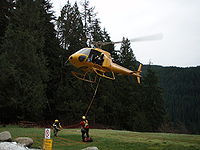- Helicopter Flight Rescue System
-
The Helicopter Flight Rescue System (HFRS), also known as Human External Transport (HETs), is a helicopter insertion and extraction tool which as under the Canadian Aviation Regulations (CARs) is authorized for use in Forest Fire Fighting, Law Enforcement and Search and Rescue. Under CARs, HFRS falls under Class D operations, which is that it involves a jettisonable human external load suspended beneath the landing gear of the helicopter. By regulation, air carriers, operations personnel, and essential aircrew are required to be extensively trained. There must also be a memorandum of understanding between the tasking agency and the air operator in order to ensure a good working relationship.[1] In British Columbia, the Provincial Emergency Program allows volunteer search and rescue societies to perform HFRS to conduct various rescue missions.[2] Given the benefits of extending a rescuer below the aircraft, thus allowing the aircraft to remain clear of obstacles while a rescue/insertion/extraction is performed, it is evident that this is an essential life saving tool. This system is commonly referred to as longline rescue and involves a rescuer being attached to the bottom of a longline and being slung to a rescue site. This allows the pilot to insert the rescuer into most types of terrain (angle, obstacles, and hazards permitting).[3]
Contents
HFRS in British Columbia
One of the pioneer search and rescue teams in Canada of the Helicopter Flight Rescue System was and continues to be, North Shore Rescue. This organization recognizing a need to move beyond reliance on conventional hover entry-exit techniques (still widely used)[4] implemented the system to the team in 1996. Since then, it has been a life saving tool, in many of their rescues.[5] With benefits come costs, and much of those costs include the heavy price of training given that search and rescue members are volunteers. North Shore Rescue trains heavily to stay up to speed.[6] With HFRS' growing popularity in BC, and its relative simplicity, many more teams have received kits and have begun using it. Teams in the Lower Mainland or Metro Vancouver who utilize this tool include North Shore Rescue, Chilliwack, Squamish and Whistler.[7]
System Components
The HFRS system has multiple components which ultimately safely suspend a rescuer under the helicopter (extended below the skids) with two distinct actions required to release the load, and load bearing redundancy. The components include:
Component Description Belly Band A strap which is fitted through the cabin of the aircraft (encircling the aircraft structure) that provides a secondary point of attachment and release. This adds the redundancy the system requires. Release is achieved with an integrated quick release device, similar to that used on parachutes. link Y-lanyard The Y-lanyard connects the belly band and the aircraft electric release hook to the main load line. link Main load line The main load line is a high visibility low-stretch aeronautically approved rope used to suspend the load under the aircraft. link Rescue Harness The rescue harness is the ultimate point of attachment for rescuers to the system. link Aerial Rescue Platform (ARP) The aerial rescue platform is used to carry an injured patient. ARP Pictures of these components can be viewed in the gallery below. Ultimately, this system is a versatile and safe way of executing complicated rescues in often dangerous and unforgiving terrain.[8]
Pictures
References
External links
Categories:- Rescue aviation
Wikimedia Foundation. 2010.









